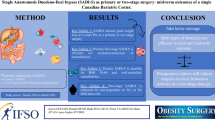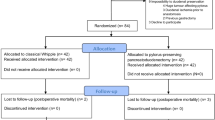Abstract
Background
Pancreaticojejunostomy (PJ) reconstruction is the Achilles’ heel of laparoscopic pancreaticoduodenectomy (LPD). However, only a few studies have focused on the performance of this difficult procedure laparoscopically.
Methods
We present a safe and feasible technique of duct-to-mucosa pancreaticojejunostomy for LPD, named Bing’s anastomosis. Our study included 238 cases of LPDs that underwent Bing’s anastomosis. Data on the demographic characteristics, operative outcomes (total operative time, PJ duration, and estimated blood loss), and postoperative results (length of hospital stay, recovery of bowel function, and rates of postoperative morbidity and mortality) of the cases were prospectively collected and retrospectively analyzed.
Results
Only one patient (0.4%) in our series required conversion to open surgery as a result of uncontrolled bleeding from the superior mesenteric artery. The average operative time was 358 min (220 min to 495 min). The mean duration for PJ was 23 min (19 min to 33 min). The mean estimated blood loss was 112 ml (50 ml to 800 ml). The overall incidence of pancreatic fistula was 21.4% and included 42 cases (17.6%) of biochemical leak, eight cases (3.4%) of Grade B, and one case (0.4%) of Grade C pancreatic fistulas. The 90-day mortality was 0.4%.
Conclusions
Bing’s anastomosis is a safe, reliable, and rapid PJ technique for LPD that is associated with favorable outcomes and a low risk of pancreatic fistula. However, its safety and feasibility should be verified by performing prospective randomized controlled trials at different institutions.


Similar content being viewed by others
References
Specht G, Stinshoff K (2001) [Walther Kausch (1867–1928) and his significance in pancreatic surgery]. Zentralbl Chir 126:479–481
Bassi C, Butturini G, Molinari E, Mascetta G, Salvia R, Falconi M, Gumbs A, Pederzoli P (2004) Pancreatic fistula rate after pancreatic resection. The importance of definitions. Dig Surg 21:54–59
Sun X, Zhang Q, Zhang J, Lou Y, Fu Q, Zhang X, Liang T, Bai X (2016) Meta-analysis of invagination and duct-to-mucosa pancreaticojejunostomy after pancreaticoduodenectomy: an update. Int J Surg 36:240–247
Benzoni E, Zompicchiatti A, Saccomano E, Lorenzin D, Baccarani U, Adani G, Noce L, Uzzau A, Cedolini C, Bresadola F, Intini S (2008) Postoperative complications linked to pancreaticoduodenectomy. An analysis of pancreatic stump management. J Gastrointestin Liver Dis 17:43–47
Han HJ, Choi SB, Lee JS, Kim WB, Song TJ, Suh SO, Kim YC, Choi SY (2011) Reliability of continuous suture of pancreaticojejunostomy after pancreaticoduodenectomy. Hepatogastroenterology 58:2132–2139
Grobmyer SR, Pieracci FM, Allen PJ, Brennan MF, Jaques DP (2007) Defining morbidity after pancreaticoduodenectomy: use of a prospective complication grading system. J Am Coll Surg 204:356–364
Berger AC, Howard TJ, Kennedy EP, Sauter PK, Bower-Cherry M, Dutkevitch S, Hyslop T, Schmidt CM, Rosato EL, Lavu H, Nakeeb A, Pitt HA, Lillemoe KD, Yeo CJ (2009) Does type of pancreaticojejunostomy after pancreaticoduodenectomy decrease rate of pancreatic fistula? A randomized, prospective, dual-institution trial. J Am Coll Surg 208:738–747; discussion 747–739
Govindarajan A, Tan JC, Baxter NN, Coburn NG, Law CH (2008) Variations in surgical treatment and outcomes of patients with pancreatic cancer: a population-based study. Ann Surg Oncol 15:175–185
Hines OJ, Reber HA (2006) Technique of pancreaticojejunostomy reconstruction after pancreaticoduodenectomy. J Hepatobil Pancreat Surg 13:185–189
Gagner M, Pomp A (1994) Laparoscopic pylorus-preserving pancreatoduodenectomy. Surg Endosc 8:408–410
Zhang H, Wu X, Zhu F, Shen M, Tian R, Shi C, Wang X, Xiao G, Guo X, Wang M, Qin R (2016) Systematic review and meta-analysis of minimally invasive versus open approach for pancreaticoduodenectomy. Surg Endosc 30:5173–5184
Nigri G, Petrucciani N, La Torre M, Magistri P, Valabrega S, Aurello P, Ramacciato G (2014) Duodenopancreatectomy: open or minimally invasive approach? Surgeon 12:227–234
Liao CH, Wu YT, Liu YY, Wang SY, Kang SC, Yeh CN, Yeh TS (2016) Systemic Review of the Feasibility and Advantage of Minimally Invasive Pancreaticoduodenectomy. World J Surg 40:1218–1225
Bassi C, Marchegiani G, Dervenis C, Sarr M, Abu Hilal M, Adham M, Allen P, Andersson R, Asbun HJ, Besselink MG, Conlon K, Del Chiaro M, Falconi M, Fernandez-Cruz L, Fernandez-Del Castillo C, Fingerhut A, Friess H, Gouma DJ, Hackert T, Izbicki J, Lillemoe KD, Neoptolemos JP, Olah A, Schulick R, Shrikhande SV, Takada T, Takaori K, Traverso W, Vollmer CR, Wolfgang CL, Yeo CJ, Salvia R, Buchler M, International Study Group on Pancreatic (2017) The 2016 update of the International Study Group (ISGPS) definition and grading of postoperative pancreatic fistula: 11 Years After. Surgery 161:584–591
Wente MN, Bassi C, Dervenis C, Fingerhut A, Gouma DJ, Izbicki JR, Neoptolemos JP, Padbury RT, Sarr MG, Traverso LW, Yeo CJ, Buchler MW (2007) Delayed gastric emptying (DGE) after pancreatic surgery: a suggested definition by the International Study Group of Pancreatic Surgery (ISGPS). Surgery 142:761–768
Clerveus M, Morandeira-Rivas A, Picazo-Yeste J, Moreno-Sanz C (2014) Pancreaticogastrostomy versus pancreaticojejunostomy after pancreaticoduodenectomy: a systematic review and meta-analysis of randomized controlled trials. J Gastrointest Surg 18:1693–1704
Que W, Fang H, Yan B, Li J, Guo W, Zhai W, Zhang S (2015) Pancreaticogastrostomy versus pancreaticojejunostomy after pancreaticoduodenectomy: a meta-analysis of randomized controlled trials. Am J Surg 209:1074–1082
Menahem B, Guittet L, Mulliri A, Alves A, Lubrano J (2015) Pancreaticogastrostomy is superior to pancreaticojejunostomy for prevention of pancreatic fistula after pancreaticoduodenectomy: an updated meta-analysis of randomized controlled trials. Ann Surg 261:882–887
Hua J, He Z, Qian D, Meng H, Zhou B, Song Z (2015) Duct-to-Mucosa Versus Invagination Pancreaticojejunostomy Following Pancreaticoduodenectomy: a Systematic Review and Meta-Analysis. J Gastrointest Surg 19:1900–1909
Ji W, Shao Z, Zheng K, Wang J, Song B, Ma H, Tang L, Shi L, Wang Y, Li X, Song B, Zhang Y, Jin G (2015) Pancreaticojejunostomy with double-layer continuous suturing is associated with a lower risk of pancreatic fistula after pancreaticoduodenectomy: a comparative study. Int J Surg 13:84–89
Tsuji M, Kimura H, Konishi K, Yabushita K, Maeda K, Kuroda Y (1998) Management of continuous anastomosis of pancreatic duct and jejunal mucosa after pancreaticoduodenectomy: historical study of 300 patients. Surgery 123:617–621
Adam MA, Thomas S, Youngwirth L, Pappas T, Roman SA, Sosa JA (2017) Defining a Hospital Volume Threshold for Minimally Invasive Pancreaticoduodenectomy in the United States. JAMA Surg 152:336–342
Funding
This study was funding by National Institutes of Health of China (W2017ZWS07).
Author information
Authors and Affiliations
Corresponding author
Ethics declarations
Disclosures
Dr. Yunqiang Cai, Hua Luo, Yongbin Li, Pan Gao, and Bing Peng have no conflicts of interest or financial ties to disclose.
Rights and permissions
About this article
Cite this article
Cai, Y., Luo, H., Li, Y. et al. A novel technique of pancreaticojejunostomy for laparoscopic pancreaticoduodenectomy. Surg Endosc 33, 1572–1577 (2019). https://doi.org/10.1007/s00464-018-6446-z
Received:
Accepted:
Published:
Issue Date:
DOI: https://doi.org/10.1007/s00464-018-6446-z




